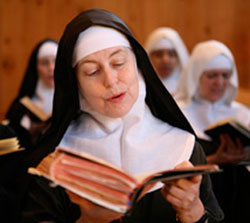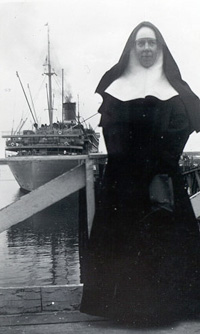
 |
|
|
 Gregorian chant is contemplative music that touches the soul and raises the heart to God. It is the sacred music of the Church, expressing the words of Scripture in Latin, the ancient language of the Church. It is, in a way, the Word made song. We invite you to come and experience for yourself the contemplative, timeless beauty of Gregorian chant.
Gregorian chant is contemplative music that touches the soul and raises the heart to God. It is the sacred music of the Church, expressing the words of Scripture in Latin, the ancient language of the Church. It is, in a way, the Word made song. We invite you to come and experience for yourself the contemplative, timeless beauty of Gregorian chant.
SUNG PRAYER
PERSONAL PRAYER While Gregorian chant is the sung prayer of the Church, and that of our monastery, it can also be a profound source and medium of personal prayer.  Its contemplative beauty deepens the meaning and mystery of the word. Gregorian chant is marked by a moving meditative cadence. It touches the depths of the soul. It shows joy, sorrow, repentance, petition, hope, praise or thanksgiving….It makes the psalms come alive. (Cardinal Francis Arinze) Gregorian chant can be described as a “prayer of song.” In the words of Saint Augustine, To sing is to pray twice, meaning that it is the singing itself that becomes the prayer. As an act of prayer, the chant can transform us. In his Holy Rule, Saint Benedict exhorted his monks to conform their hearts to their song: Sic stemus ad psallendum ut mens nostra concordet voci nostrae. (“Thus may we sing so that our mind may be in harmony with our voice.”) Through this prayer we strive to become what we sing, offering up not just our voices but our selves as we do so. Pope Emeritus Benedict XVI has described this process of “becoming” through song as an integral part of monastic culture: The culture of singing is the culture of being. (Address to the College des Bernardins, Paris, 2008). Its contemplative beauty deepens the meaning and mystery of the word. Gregorian chant is marked by a moving meditative cadence. It touches the depths of the soul. It shows joy, sorrow, repentance, petition, hope, praise or thanksgiving….It makes the psalms come alive. (Cardinal Francis Arinze) Gregorian chant can be described as a “prayer of song.” In the words of Saint Augustine, To sing is to pray twice, meaning that it is the singing itself that becomes the prayer. As an act of prayer, the chant can transform us. In his Holy Rule, Saint Benedict exhorted his monks to conform their hearts to their song: Sic stemus ad psallendum ut mens nostra concordet voci nostrae. (“Thus may we sing so that our mind may be in harmony with our voice.”) Through this prayer we strive to become what we sing, offering up not just our voices but our selves as we do so. Pope Emeritus Benedict XVI has described this process of “becoming” through song as an integral part of monastic culture: The culture of singing is the culture of being. (Address to the College des Bernardins, Paris, 2008). THE HISTORY OF CHANT AT THE ABBEY I had an intuitive conviction that the Chant had the power to communicate the life of God as no other music does. (Mother Benedict, Lady Abbess) It was out of the darkness of the Second World War that our foundress, Mother Benedict, came to experience Gregorian chant in a profound way.  As an American in France at that time, she was forced into hiding from the Gestapo for much of the war. It was during these prolonged periods of confinement that she studied Gregorian chant intensively. When Mother Benedict returned to the United States in 1946 to establish a new foundation here, she firmly believed that singing the chant would be an essential work of the community. It was providential then that, as she was about to board the S.S. Argentina to sail to America, she discovered that another passenger waiting to board was Dom Germain Cozien, Abbot of Solesmes, the French abbey that had led the revival of chant in Europe which began in the nineteenth century! During the crossing, a friendship formed and, on learning of her aspiration to found a monastery, Abbot Cozien offered to send his renowned choirmaster Dom Gajard to teach the prospective nuns Gregorian chant, certain that Mother Benedict would found her abbey and attract vocations. Dom Gajard did indeed visit in time and instructed the nuns in Gregorian chant, forming a life-long relationship with the Abbey. He was often brought to Regina Laudis by Theodore Marier, an ardent disciple of Dom Gajard. Dr. Marier was Director of Music at St. Paul’s Church in Cambridge, Massachusetts and founder of the Boston Archdiocesan Choir School. When, in 1970, Dom Gajard was no longer able to travel to America, Lady Abbess asked Dr. Marier to continue teaching the Chant at Regina Laudis, which he did with great energy and pleasure for the rest of his life, helping the community to prepare our first two chant CDs, Women in Chant and Recordare. He entrusted his legacy in Gregorian chant to the Abbey and we were privileged to collaborate with Scott Turkington (currently principal organist and choirmaster for the Roman Catholic Cathedral of St. John the Baptist in Charleston, South Carolina) to produce A Gregorian Chant Master Class, a workbook and companion CD giving the principles of Chant, with examples sung by the Regina Laudis Choir and the Stamford Schola Gregoriana. As an American in France at that time, she was forced into hiding from the Gestapo for much of the war. It was during these prolonged periods of confinement that she studied Gregorian chant intensively. When Mother Benedict returned to the United States in 1946 to establish a new foundation here, she firmly believed that singing the chant would be an essential work of the community. It was providential then that, as she was about to board the S.S. Argentina to sail to America, she discovered that another passenger waiting to board was Dom Germain Cozien, Abbot of Solesmes, the French abbey that had led the revival of chant in Europe which began in the nineteenth century! During the crossing, a friendship formed and, on learning of her aspiration to found a monastery, Abbot Cozien offered to send his renowned choirmaster Dom Gajard to teach the prospective nuns Gregorian chant, certain that Mother Benedict would found her abbey and attract vocations. Dom Gajard did indeed visit in time and instructed the nuns in Gregorian chant, forming a life-long relationship with the Abbey. He was often brought to Regina Laudis by Theodore Marier, an ardent disciple of Dom Gajard. Dr. Marier was Director of Music at St. Paul’s Church in Cambridge, Massachusetts and founder of the Boston Archdiocesan Choir School. When, in 1970, Dom Gajard was no longer able to travel to America, Lady Abbess asked Dr. Marier to continue teaching the Chant at Regina Laudis, which he did with great energy and pleasure for the rest of his life, helping the community to prepare our first two chant CDs, Women in Chant and Recordare. He entrusted his legacy in Gregorian chant to the Abbey and we were privileged to collaborate with Scott Turkington (currently principal organist and choirmaster for the Roman Catholic Cathedral of St. John the Baptist in Charleston, South Carolina) to produce A Gregorian Chant Master Class, a workbook and companion CD giving the principles of Chant, with examples sung by the Regina Laudis Choir and the Stamford Schola Gregoriana.The important role of Gregorian chant in the Church was reaffirmed at Vatican II as  a unique and universal spiritual heritage. Despite this, there were signs, Mother Benedict said later, that the chant might be thrown out. The Abbess continued to insist on the spiritual and aesthetic value of Gregorian chant, even as many other monasteries were turning to more contemporary musical expressions. Also concerned for the future of chant was Pope Paul VI who, as Cardinal Montini, had supported Mother Benedict’s petition to Rome to found a monastery. The Cardinal had personally asked Mother Benedict to continue to uphold the chant as an invaluable living tradition of the church. That promise has been kept, and the sound of Gregorian chant has characterized the Abbey of Regina Laudis for over fifty years. The Abbey still continues to follow what is known as the Solesmes Method of singing chant. a unique and universal spiritual heritage. Despite this, there were signs, Mother Benedict said later, that the chant might be thrown out. The Abbess continued to insist on the spiritual and aesthetic value of Gregorian chant, even as many other monasteries were turning to more contemporary musical expressions. Also concerned for the future of chant was Pope Paul VI who, as Cardinal Montini, had supported Mother Benedict’s petition to Rome to found a monastery. The Cardinal had personally asked Mother Benedict to continue to uphold the chant as an invaluable living tradition of the church. That promise has been kept, and the sound of Gregorian chant has characterized the Abbey of Regina Laudis for over fifty years. The Abbey still continues to follow what is known as the Solesmes Method of singing chant. CHANT AT THE ABBEY TODAY CHANT AT THE ABBEY TODAYGregorian chant is not something the Abbey "preserves" or "performs" simply as a treasured relic of the Church’s heritage. Chant for us is a way of life. We are privileged to continue our study of the Chant under the direction of our Abbess, Mother David Serna, who is an accomplished musician and directed the monastic Choir for our third CD, The Announcement of Christmas Seven times a day, and once in the middle of the night, the nuns of Regina Laudis come together to pray the Divine Office, an arrangement set forth by Saint Benedict in his Rule more than 1500 years ago. For us, Gregorian chant is life-giving. In the words of Mother Benedict, Chant is a medium that has the power to release and strengthen people. The chant is for me unique and superior to all other musical responses to Scripture. There is nothing that equals it because of its paradoxical simplicity and complexity. The chant centers our mission to praise God at all times, a mission expressed in the Abbey’s motto: Non recedat laus—Let praise never cease. Watch a video clip of an Abbey class with Dr. Theodore Marier from the 1980's on the Rhythm of Kyrie XVI. |
| Copyright © 2013 Abbey of Regina Laudis. All rights reserved. | |